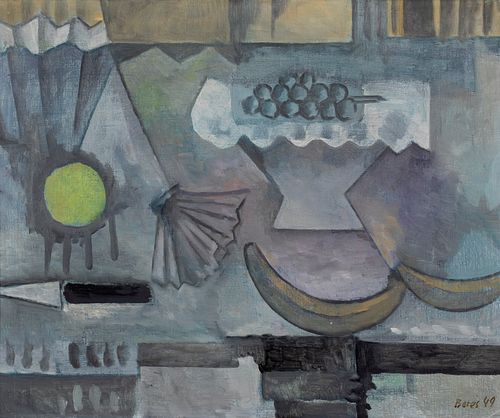FRANCISCO BORÉS LÓPEZ (Madrid, 1898 - Paris, 1972). "Still life", 1949. Oil on canvas. Signed and dated in the lower right corner.
Lot 93
About Seller
Setdart Auction House
Carrer Aragó 346
Barcelona
Spain
Setdart Subastas was born in 2004 and is currently the first online art auction in Spain with solidity, prestige and reliability guaranteed by our more than 60,000 users. Setdart has a young, dynamic and enterprising team ready to successfully manage the purchase and sale of art works through custom...Read more
Estimate:
$15,000 - $20,000
Absentee vs Live bid
Two ways to bid:
- Leave a max absentee bid and the platform will bid on your behalf up to your maximum bid during the live auction.
- Bid live during the auction and your bids will be submitted real-time to the auctioneer.
Bid Increments
| Price | Bid Increment |
|---|---|
| $0 | $10 |
| $200 | $25 |
| $500 | $50 |
| $1,000 | $100 |
| $3,000 | $200 |
| $5,000 | $500 |
| $10,000 | $1,000 |
| $20,000 | $2,000 |
| $50,000 | $5,000 |
About Auction
By Setdart Auction House
Jun 17, 2021
Set Reminder
2021-06-17 06:15:00
2021-06-17 06:15:00
America/New_York
Bidsquare
Bidsquare : 19th & 20th Century Contemporary Art - Select Lots
https://www.bidsquare.com/auctions/setdart-auction-house/19th-20th-century-contemporary-art---select-lots-7081
Setdart Auction House sofia@setdart.com
Setdart Auction House sofia@setdart.com
- Lot Description
FRANCISCO BORÉS LÓPEZ (Madrid, 1898 - Paris, 1972). "Still life", 1949. Oil on canvas. Signed and dated in the lower right corner. This work appears in the Bores Archive and is included in the Annex to the raison d'être in preparation. Measurements: 46 x 55 cm; 72 x 80 cm (frame). In this work, dated 1949, Borés offers us an interior scene constituted by an aesthetic of synthetic character in its forms and, at the same time, of great expressive intensity, constructed through broad brushstrokes that present an energetic invoice in the stroke. Thanks to the use of schematic plastic elements, the artist manages to create a tactile effect and a visual purity free of any artifice or anecdotal detail. Francisco Borés studied at Cecilio Pla's painting academy, where he met Pancho Cossío, Manuel Ángeles Ortiz and Joaquín Peinado, among others. He also frequented the literary gatherings in Madrid related to ultraism. During this period he made engravings for a large number of magazines, such as "Horizonte" or "Revista de Occidente", and attended the Academia Libre de Julio Moisés, where he coincided with Dalí and Benjamín Palencia. In 1922 he participates for the first time in the National Exhibition of Fine Arts, and three years later he will show his work in the first Exhibition of the Society of Iberian Artists, but the lack of interest of the Madrid public for young art drives him to go to Paris. In the French capital he came into contact with Picasso and Juan Gris, and made his individual debut in 1927. The following year he had his first solo exhibition in the United States, and in 1930 he exhibited again, this time as part of a group exhibition at the Museum of Modern Art in New York. During the following years he continues to hold solo exhibitions in prominent galleries in Paris and London, among which Georges Petit and Zwemmer galleries stand out. After the Second World War he resumes his exhibition activity, and in 1947 the French State acquires, for the first time, a work by Borés. In 1949 the Museum of Modern Art in New York bought his paintings. In 1969 he exhibited at the Theo Gallery in Madrid, which meant his approach to the Spanish public, which was practically unaware of his work, except in professional circles where, on the other hand, it was highly appreciated. In 1971 he exhibited again at the same Theo Gallery, and died in Paris in 1972. The critic Joaquín de la Puente points out several stages in Borés' production: renewed classicism (1923-25), neo cubism (1925-29), fruit-painting (1929-33), interior scenes (1934-1949) and white style (1949-69). Francisco Borés is represented in the most important museums around the world, including the Georges Pompidou Center in Paris, the Fine Arts Museums of Bilbao, Buenos Aires, Jerusalem, Gotemborg and Baltimore, the MOMA in New York, the Museo Nacional Centro de Arte Reina Sofía, the National Galleries of Athens, Brno and Edinburgh, the Museo Patio Herreriano in Valladolid, and the Modern Art Museums of Stockholm, Turin and Madrid.
- Shipping Info
-
In-house shipping available. Please inquire at admin@setdart.com.
-
- Buyer's Premium



 EUR
EUR CAD
CAD AUD
AUD GBP
GBP MXN
MXN HKD
HKD CNY
CNY MYR
MYR SEK
SEK SGD
SGD CHF
CHF THB
THB
















